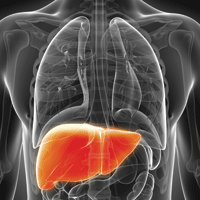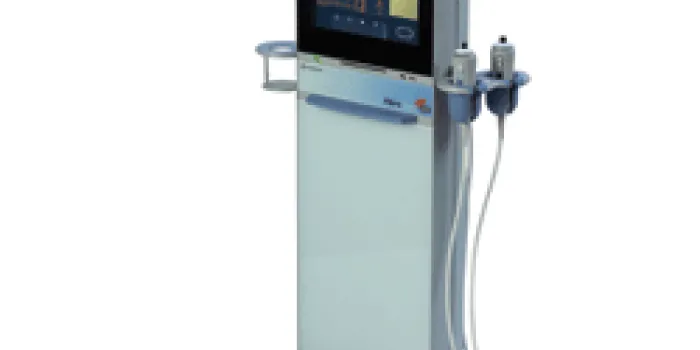Sound waves, such as ultrasound, are used in everything from home motion-detector sensors to evaluating fetal development during pregnancy. They’re also used for internal organ imaging. In April 2013, the US Food and Drug Administration (FDA) approved the use of FibroScan®, a device that uses sound waves to perform transient elastography, a measurement of the liver’s elasticity. Now liver biopsy, considered the gold standard for assessing liver health in people with chronic hepatitis C virus (HCV), hepatitis B virus and other liver disorders, has a less invasive challenger.
Although new to the US, FibroScan, manufactured by the Parisian company Echosens, has been on the market since 2003. It is used in more than 70 nations. In Spain, it has replaced liver biopsy for staging fibrosis, the extent of scar tissue in the liver, an indicator of liver disease.
FibroScan function
FibroScan uses an ultrasound transducer, a probe placed between your ribs on your right side, on a small area of skin coated with a gel. The probe emits sound waves that pass through the liver and bounce back as shear waves. The stiffer the liver, the quicker the waves travel and the greater the degree of fibrosis. After 10 readings are taken, the total is averaged. The result is given in kiloPascals (kPa).
Liver fibrosis is typically staged using the Metavir score. F0 indicates no scarring; FI means there is minimal scarring; F2 and F3 indicate more extensive scarring; F4 signals cirrhosis, or irreversible scarring.
FibroScan is most accurate at opposite ends of the fibrosis scoring system. “It may not be very good at telling someone whether they have a 1 or a 2 on the Metavir score,” says Kenneth Sherman, MD, PhD, Gould Professor of Medicine and director of the Division of Digestive Diseases at the University of Cincinnati College of Medicine. “In terms of diagnosis of cirrhosis, it is a very good test.”
Comparing FibroScan and biopsy
When FibroScan and biopsy go head to head, they each have advantages and disadvantages. FibroScan is noninvasive (no needles or incisions), requires no sedation and causes no side effects. It is a painless procedure that takes about 10–15 minutes in your doctor’s office, with immediate results.
On the other hand, biopsies (especially for patients with hemophilia) are performed in a hospital setting, can be painful and can cause bleeding. Further, because biopsies can cost $2,000–$3,000, most insurance companies only cover repeated tests every few years. In contrast, FibroScan, which costs about $200, allows for more frequent serial testing. “Some longitudinal data show that changes over time—not every week or every month, but every year—may reflect the overall degree of fibrosis of the liver,” says Sherman.
The National Hemophilia Foundation’s Medical and Scientific Advisory Council (MASAC) published its MASAC Recommendation #223: “MASAC recommendations on liver biopsy in individuals with hemophilia.” In it, the advisory group states that noninvasive tests for liver function are preferred in people with bleeding disorders. However, if the results are inconclusive, liver biopsy may be necessary, the document says.
It’s important to weigh sampling size and error rate when it comes to FibroScan and liver biopsy. Sampling errors can occur in up to one-third of biopsies, resulting in staging fibrosis too high or too low. “Liver biopsies are often not performed at an optimal level in terms of the size, made up of the width (the gauge of the needle used) and length that you need to determine the presence or absence of cirrhosis or fibrosis,” Sherman says.

Eraxion/Thinkstock
However, a well-done biopsy can provide information that its competitor cannot. “FibroScan cannot tell you about disease activity,” says Sherman. “It will not tell you about co-morbid conditions.” That means people with hemophilia, HIV and HCV can still benefit from biopsy. “Biopsies provide evidence of chronic injury associated with antiretroviral therapies,” he says. Such injuries include steatosis (fatty liver) and nonalcoholic steatohepatitis from drugs that are toxic to the liver, he adds. Biopsies can also detect inflammation caused by bacterial infection, which is more likely to occur in people with HIV, says Sherman.
In some cases, biopsies and FibroScan can be partners. Initial assessment of liver damage could be done via biopsy and correlated with FibroScan, says Sherman. FibroScan could then be used for future tests. “Changes in the FibroScan score would then be meaningful. They would represent either progression or regression,” he says.
Limitations
FibroScan has limitations. The manufacturer’s website says it is not indicated for people with implantable medical devices, pregnant women or patients with HCV who have ascites, fluid buildup in their abdomen.
Although the cost to perform a FibroScan is relatively low, the equipment is not. Sherman estimates the equipment outlay at $131,000. “I think that upfront cost will be a barrier for many organizations and individual practices,” he says. Despite the price tag, Sherman has his eye on the scanning device. “I’m anxious to get one,” he says.

